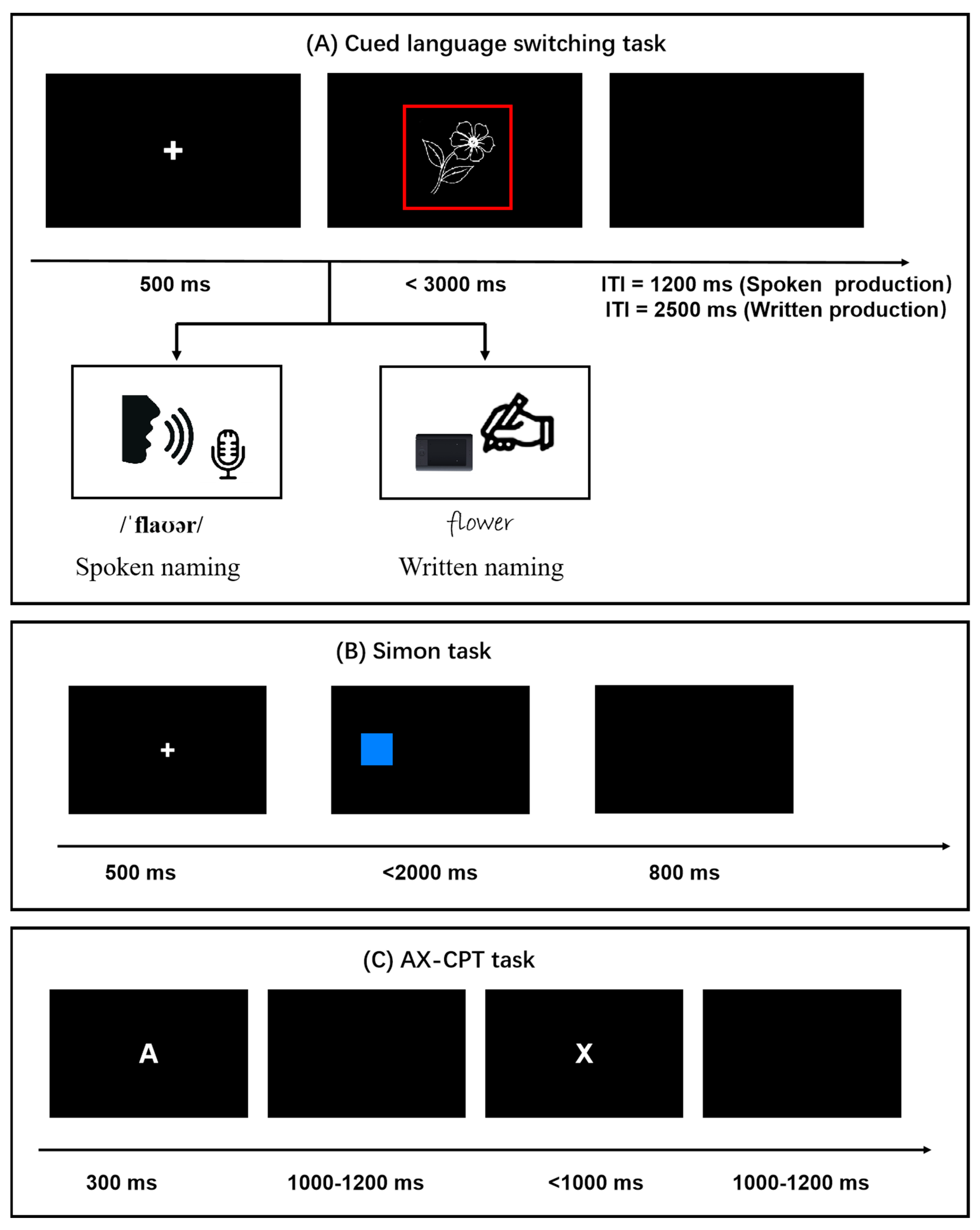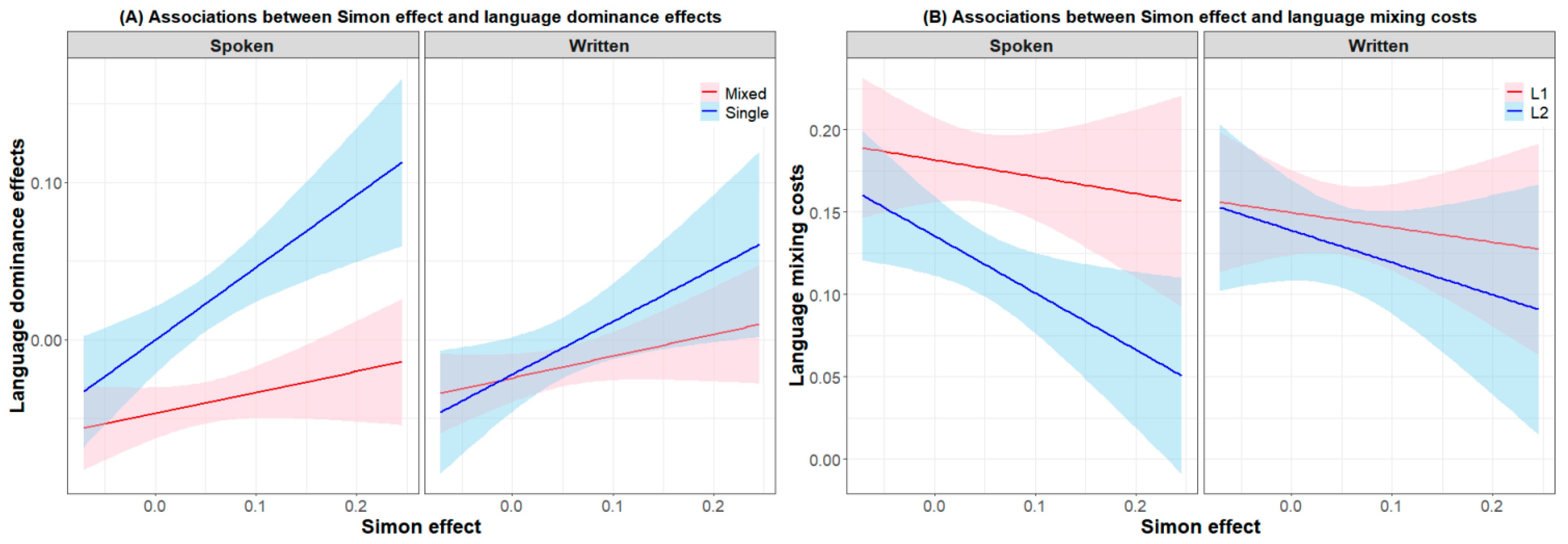The Effects of Cognitive Control on the Subcomponents of Language Control in Spoken and Written Productions
Abstract
:1. Introduction
2. Methods
2.1. Participants
2.2. Materials and Procedure
2.2.1. Cued Language Switching Task
2.2.2. Simon Task
2.2.3. AX-CPT Task
2.3. Data Analysis
2.3.1. Cued Language Switching Task
2.3.2. Simon Task
2.3.3. AX-CPT Task
3. Results
3.1. Comparison of Bilingual Language Control between the Spoken and Written Modalities
3.1.1. Switch Costs and Reversed Language Dominance Effect
3.1.2. Mixing Costs
3.2. Bilingual Language Control and Cognitive Control Ability
3.2.1. The Association between Language Control Performance and Individuals’ General Inhibitory Control Ability
3.2.2. Association between Language Control Performance and Individuals’ Proactive Control Strategies
4. Discussion
4.1. Similarities and Differences in Control Mechanisms between Bilingual Speaking and Writing
4.2. Relationship between Bilingual Language Performance and Cognitive Control
4.3. Limitations
5. Conclusions
Author Contributions
Funding
Institutional Review Board Statement
Informed Consent Statement
Data Availability Statement
Conflicts of Interest
Appendix A
| English Name | Chinese Name | |
|---|---|---|
| 1 | bed | 床 |
| 2 | chair | 椅 |
| 3 | dog | 狗 |
| 4 | eye | 眼 |
| 5 | flower | 花 |
| 6 | gun | 枪 |
| 7 | house | 房 |
| 8 | leaf | 叶 |
| 9 | moon | 月 |
| 10 | pen | 笔 |
| 11 | star | 星 |
| 12 | tiger | 虎 |
Appendix B

References
- Costa, A.; Santesteban, M. Lexical access in bilingual speech production: Evidence from language switching in highly proficient bilinguals and L2 learners. J. Mem. Lang. 2004, 50, 491–511. [Google Scholar] [CrossRef]
- Declerck, M.; Koch, I.; Philipp, A.M. Digits vs. pictures: The influence of stimulus type on language switching. Biling. Lang. Cogn. 2012, 15, 896–904. [Google Scholar] [CrossRef]
- Philipp, A.M.; Gade, M.; Koch, I. Inhibitory processes in language switching: Evidence from switching language-defined response sets. Eur. J. Cogn. Psychol. 2007, 19, 395–416. [Google Scholar] [CrossRef]
- Green, D.W. Mental control of the bilingual lexico-semantic system. Biling. Lang. Cogn. 1998, 1, 67–81. [Google Scholar] [CrossRef]
- Meuter, R.F.I.; Allport, A. Bilingual language switching in naming: Asymmetrical costs of language selection. J. Mem. Lang. 1999, 40, 25–40. [Google Scholar] [CrossRef]
- Abutalebi, J.; Green, D.W. Bilingual language production: The neurocognition of language representation and control. J. Neurolinguistics 2007, 20, 242–275. [Google Scholar] [CrossRef]
- Bialystok, E.; Craik, F.; Freedman, M. Bilingualism as protection against the onset of symptoms of dementia. Neuropsychologia 2007, 45, 459–464. [Google Scholar] [CrossRef]
- Bialystok, E.; Craik, F.I.; Ryan, J. Executive control in a modified antisaccade task: Effects of aging and bilingualism. J. Exp. Psychol. Learn. Mem. Cogn. 2006, 32, 1341–1354. [Google Scholar] [CrossRef]
- Declerck, M. What about proactive language control? Psychon. Bull. Rev. 2020, 27, 24–35. [Google Scholar] [CrossRef]
- Gollan, T.H.; Ferreira, V.S. Should I stay or should I switch? A cost–benefit analysis of voluntary language switching in young and aging bilinguals. J. Exp. Psychol. Learn. Mem. Cogn. 2009, 35, 640–665. [Google Scholar] [CrossRef]
- Gollan, T.H.; Kleinman, D.; Wierenga, C.E. What’s easier: Doing what you want, or being told what to do? Cued versus voluntary language and task switching. J. Exp. Psychol. Gen. 2014, 143, 2167–2195. [Google Scholar] [CrossRef]
- Heikoop, K.W.; Declerck, M.; Los, S.A.; Koch, I. Dissociating language-switch costs from cue-switch costs in bilingual language switching. Biling. Lang. Cogn. 2016, 19, 921–927. [Google Scholar] [CrossRef]
- Christoffels, I.K.; Firk, C.; Schiller, N.O. Bilingual language control: An event-related brain potential study. Brain Res. 2007, 1147, 192–208. [Google Scholar] [CrossRef] [PubMed]
- Jylkkä, J.; Lehtonen, M.; Lindholm, F.; Kuusakoski, A.; Laine, M. The relationship between general executive functions and bilingual switching and monitoring in language production. Biling. Lang. Cogn. 2018, 21, 505–522. [Google Scholar] [CrossRef]
- Prior, A.; Gollan, T.H. Good language-switchers are good task-switchers: Evidence from Spanish–English and Mandarin–English bilinguals. J. Int. Neuropsychol. Soc. 2011, 17, 682–691. [Google Scholar] [CrossRef] [PubMed]
- Ma, F.; Li, S.; Guo, T. Reactive and proactive control in bilingual word production: An investigation of influential factors. J. Mem. Lang. 2016, 86, 35–59. [Google Scholar] [CrossRef]
- Mosca, M.; de Bot, K. Bilingual language switching: Production vs. Recognition. Front. Psychol. 2017, 8, 934. [Google Scholar] [CrossRef]
- Peeters, D.; Dijkstra, T. Sustained inhibition of the native language in bilingual language production: A virtual reality approach. Biling. Lang. Cogn. 2018, 21, 1035–1061. [Google Scholar] [CrossRef]
- Zhang, M.; Li, S.; Ma, F.; Kang, C.; Guo, T. Mixed language training enhances proactive language control in bilingual language production. Lang. Cogn. Neurosci. 2021, 36, 152–166. [Google Scholar] [CrossRef]
- Bobb, S.C.; Wodniecka, Z. Language switching in picture naming: What asymmetric switch costs (do not) tell us about inhibition in bilingual speech planning. J. Cogn. Psychol. 2013, 25, 568–585. [Google Scholar] [CrossRef]
- Declerck, M.; Koch, I. The concept of inhibition in bilingual control. Psychol. Rev. 2023, 130, 953. [Google Scholar] [CrossRef] [PubMed]
- Liu, C.; Jiao, L.U.; Wang, Z.; Wang, M.; Wang, R.; Wu, Y.J. Symmetries of bilingual language switch costs in conflicting versus non-conflicting contexts. Biling. Lang. Cogn. 2019, 22, 624–636. [Google Scholar] [CrossRef]
- Verhoef, K.; Roelofs, A.; Chwilla, D.J. Role of inhibition in language switching: Evidence from event-related brain potentials in overt picture naming. Cognition 2009, 110, 84–99. [Google Scholar] [CrossRef] [PubMed]
- Verhoef, K.M.; Roelofs, A.; Chwilla, D.J. Electrophysiological evidence for endogenous control of attention in switching between languages in overt picture naming. J. Cogn. Neurosci. 2010, 22, 1832–1843. [Google Scholar] [CrossRef]
- Broos, W.P.; Bencivenni, A.; Duyck, W.; Hartsuiker, R.J. Delayed picture naming in the first and second language. Biling. Lang. Cogn. 2021, 24, 389–400. [Google Scholar] [CrossRef]
- Hanulová, J.; Davidson, D.J.; Indefrey, P. Where does the delay in L2 picture naming come from? Psycholinguistic and neurocognitive evidence on second language word production. Lang. Cogn. Process. 2011, 26, 902–934. [Google Scholar] [CrossRef]
- Bonfieni, M.; Branigan, H.P.; Pickering, M.J.; Sorace, A. Language experience modulates bilingual language control: The effect of proficiency, age of acquisition, and exposure on language switching. Acta Psychol. 2019, 193, 160–170. [Google Scholar] [CrossRef]
- Costa, A.; Santesteban, M.; Ivanova, I. How do highly proficient bilinguals control their lexicalization process? Inhibitory and language-specific selection mechanisms are both functional. J. Exp. Psychol. Learn. Mem. Cogn. 2006, 32, 1057. [Google Scholar] [CrossRef]
- Jiang, S.; Ma, L.; Chen, B. Dynamic engagement of cognitive control in intra-sentential code-switching during comprehension. Biling. Lang. Cogn. 2023, 26, 62–77. [Google Scholar] [CrossRef]
- Declerck, M.; Philipp, A.M. A review of control processes and their locus in language switching. Psychon. Bull. Rev. 2015, 22, 1630–1645. [Google Scholar] [CrossRef]
- Fink, A.; Goldrick, M. Pervasive benefits of preparation in language switching. Psychon. Bull. Rev. 2015, 22, 808–814. [Google Scholar] [CrossRef] [PubMed]
- Kleinman, D.; Gollan, T.H. Inhibition accumulates over time at multiple processing levels in bilingual language control. Cognition 2018, 173, 115–132. [Google Scholar] [CrossRef] [PubMed]
- Liu, H.; Rossi, S.; Zhou, H.; Chen, B. Electrophysiological evidence for domain-general inhibitory control during bilingual language switching. PLoS ONE 2014, 9, e110887. [Google Scholar] [CrossRef] [PubMed]
- Wong, W.L.; Maurer, U. The effects of input and output modalities on language switching between Chinese and English. Biling. Lang. Cogn. 2021, 24, 719–729. [Google Scholar] [CrossRef]
- Yang, T.; Cai, Z.G.; Lin, W.; Wang, R. Modality-general and modality-specific control mechanisms in bilingual spoken and written productions. Biling. Lang. Cogn. 2022; under third review (submitted). [Google Scholar]
- Linck, J.A.; Schwieter, J.W.; Sunderman, G. Inhibitory control predicts language switching performance in trilingual speech production. Biling. Lang. Cogn. 2012, 15, 651–662. [Google Scholar] [CrossRef]
- Liu, H.; Dunlap, S.; Wu, M.S.; Liang, L.; Lu, Y.; Chen, B. Inhibitory control predicts quasi language switching performance: Evidence from face-to-face dialogue. Lang. Cogn. Neurosci. 2017, 32, 695–708. [Google Scholar] [CrossRef]
- Jylkkä, J.; Laine, M.; Lehtonen, M. Does language switching behavior rely on general executive functions? Biling. Lang. Cogn. 2021, 24, 583–595. [Google Scholar] [CrossRef]
- Liu, H.; Liang, L.; Dunlap, S.; Fan, N.; Chen, B. The effect of domain-general inhibition-related training on language switching: An ERP study. Cognition 2016, 146, 264–276. [Google Scholar] [CrossRef]
- Botvinick, M.M.; Cohen, J.D.; Carter, C.S. Conflict monitoring and anterior cingulate cortex: An update. Trends Cogn. Sci. 2004, 8, 539–546. [Google Scholar] [CrossRef]
- Eriksen, B.A.; Eriksen, C.W. Effects of noise letters upon the identification of a target letter in a nonsearch task. Percept. Psychophys. 1974, 16, 143–149. [Google Scholar] [CrossRef]
- Simon, J.R.; Rudell, A.P. Auditory SR compatibility: The effect of an irrelevant cue on information processing. J. Appl. Psychol. 1967, 51, 300. [Google Scholar] [CrossRef] [PubMed]
- Li, S.; Botezatu, M.R.; Zhang, M.; Guo, T. Different inhibitory control components predict different levels of language control in bilinguals. Mem. Cogn. 2021, 49, 758–770. [Google Scholar] [CrossRef] [PubMed]
- Braver, T.S.; Paxton, J.L.; Locke, H.S.; Barch, D.M. Flexible neural mechanisms of cognitive control within human prefrontal cortex. Proc. Natl. Acad. Sci. USA 2009, 106, 7351–7356. [Google Scholar] [CrossRef]
- Braver, T.S. The variable nature of cognitive control: A dual mechanisms framework. Trends Cogn. Sci. 2012, 16, 106–113. [Google Scholar] [CrossRef]
- Morales, J.; Gómez-Ariza, C.J.; Bajo, M.T. Dual mechanisms of cognitive control in bilinguals and monolinguals. J. Cogn. Psychol. 2013, 25, 531–546. [Google Scholar] [CrossRef]
- Morales, J.; Yudes, C.; Gómez-Ariza, C.J.; Bajo, M.T. Bilingualism modulates dual mechanisms of cognitive control: Evidence from ERPs. Neuropsychologia 2015, 66, 157–169. [Google Scholar] [CrossRef]
- Bonfieni, M.; Branigan, H.P.; Pickering, M.J.; Sorace, A. Cognitive control in bilinguals: Effects of language experience and individual variability. Biling. Lang. Cogn. 2020, 23, 219–230. [Google Scholar] [CrossRef]
- Gullifer, J.W.; Chai, X.J.; Whitford, V.; Pivneva, I.; Baum, S.; Klein, D.; Titone, D. Bilingual experience and resting-state brain connectivity: Impacts of L2 age of acquisition and social diversity of language use on control networks. Neuropsychologia 2018, 117, 123–134. [Google Scholar] [CrossRef]
- Liu, H.; Zhang, Y.; Blanco-Elorrieta, E.; He, Y.; Chen, B. The role of proactive control on subcomponents of language control: Evidence from trilinguals. Cognition 2020, 194, 104055. [Google Scholar] [CrossRef]
- Beatty-Martínez, A.L.; Navarro-Torres, C.A.; Dussias, P.E.; Bajo, M.T.; Guzzardo Tamargo, R.E.; Kroll, J.F. Interactional context mediates the consequences of bilingualism for language and cognition. J. Exp. Psychol. Learn. Mem. Cogn. 2020, 46, 1022. [Google Scholar] [CrossRef]
- Bialystok, E.; Craik, F.I.; Luk, G. Bilingualism: Consequences for mind and brain. Trends Cogn. Sci. 2012, 16, 240–250. [Google Scholar] [CrossRef] [PubMed]
- Faul, F.; Erdfelder, E.; Lang, A.G.; Buchner, A. G*Power 3: A flexible statistical power analysis program for the social, behavioral, and biomedical sciences. Behav. Res. Methods 2007, 39, 175–191. [Google Scholar] [CrossRef] [PubMed]
- Lemhöfer, K.; Broersma, M. Introducing LexTALE: A quick and valid lexical test for advanced learners of English. Behav. Res. Methods 2012, 44, 325–343. [Google Scholar] [CrossRef] [PubMed]
- Declerck, M.; Koch, I.; Philipp, A.M. The minimum requirements of language control: Evidence from sequential predictability effects in language switching. J. Exp. Psychol. Learn. Mem. Cogn. 2015, 41, 377–394. [Google Scholar] [CrossRef]
- De Bruin, A.; Samuel, A.G.; Duñabeitia, J.A. Examining bilingual language switching across the lifespan in cued and voluntary switching contexts. J. Exp. Psychol. Hum. Percept. Perform. 2020, 46, 759. [Google Scholar] [CrossRef]
- Grunden, N.; Piazza, G.; García-Sánchez, C.; Calabria, M. Voluntary language switching in the context of bilingual aphasia. Behav. Sci. 2020, 10, 141. [Google Scholar] [CrossRef]
- Zhang, Q.; Yang, Y. The determiners of picture-naming latency. Acta Psychol. Sin. 2003, 4, 447–454. [Google Scholar]
- Poarch, G.J.; Krott, A. A bilingual advantage? An appeal for a change in perspective and recommendations for future research. Behav. Sci. 2019, 9, 95. [Google Scholar] [CrossRef]
- Gullifer, J.W.; Titone, D. Engaging proactive control: Influences of diverse language experiences using insights from machine learning. J. Exp. Psychol. Gen. 2021, 150, 414. [Google Scholar] [CrossRef]
- Zhang, H.; Diaz, M.T.; Guo, T.; Kroll, J.F. Language immersion and language training: Two paths to enhanced language regulation and cognitive control. Brain Lang. 2021, 223, 105043. [Google Scholar] [CrossRef]
- Barr, D.J.; Levy, R.; Scheepers, C.; Tily, H.J. Random effects structure for confirmatory hypothesis testing: Keep it maximal. J. Mem. Lang. 2013, 68, 255–278. [Google Scholar] [CrossRef]
- Lenth, R.V. Emmeans: Estimated Marginal Means, Aka Least-Squares Means (Version 1.8.5). 2023. Available online: https://CRAN.R-project.org/package=emmeans (accessed on 1 May 2023).
- Luque, A.; Morgan-Short, K. The relationship between cognitive control and second language proficiency. J. Neurolinguistics 2021, 57, 100956. [Google Scholar] [CrossRef]
- Ivanova, I.; Hernandez, D.C. Within-language lexical interference can be resolved in a similar way to between-language interference. Cognition 2021, 214, 104760. [Google Scholar] [CrossRef] [PubMed]
- Gade, M.; Declerck, M.; Philipp, A.M.; Rey-Mermet, A.; Koch, I. Assessing the evidence for asymmetrical switch costs and reversed language dominance effects–a meta-analysis. J. Cogn. 2021, 4, 55. [Google Scholar] [CrossRef]
- Jevtović, M.; Duñabeitia, J.A.; de Bruin, A. How do bilinguals switch between languages in different interactional contexts? A comparison between voluntary and mandatory language switching. Biling. Lang. Cogn. 2020, 23, 401–413. [Google Scholar] [CrossRef]
- Declerck, M.; Kleinman, D.; Gollan, T.H. Which bilinguals reverse language dominance and why? Cognition 2020, 204, 104384. [Google Scholar] [CrossRef]
- De Bruin, A.; Roelofs, A.; Dijkstra, T.; FitzPatrick, I. Domain-general inhibition areas of the brain are involved in language switching: fMRI evidence from trilingual speakers. NeuroImage 2014, 90, 348–359. [Google Scholar] [CrossRef] [PubMed]



| L1 (Chinese) | L2 (English) | t | p | |
|---|---|---|---|---|
| Self-rating proficiency | ||||
| Listening | 6.35 (0.70) | 3.72 (1.01) | 18.59 | <0.001 |
| Speaking | 6.16 (0.85) | 3.58 (1.03) | 17.01 | <0.001 |
| Reading | 6.06 (0.79) | 4.34 (0.92) | 13.03 | <0.001 |
| Writing | 5.23 (0.97) | 3.81 (0.88) | 9.58 | <0.001 |
| L2_AoA | 8.45 (2.35) | |||
| LexTALE | 54.21 (8.09) | |||
| Spoken Modality | Written Modality | ||||
|---|---|---|---|---|---|
| L1 | L2 | L1 | L2 | ||
| Latencies (ms) | |||||
| Switch | 875 (202) | 833 (192) | 1117 (281) | 1101 (281) | |
| Repeat | 805 (192) | 773 (173) | 1037 (261) | 1014 (259) | |
| Single | 669 (132) | 682 (119) | 893 (196) | 886 (185) | |
| Switch costs | 69 | 60 | 79 | 87 | |
| Mixing costs | 136 | 92 | 147 | 132 | |
| Error rates (%) | |||||
| Switch | 5.2 (5.9) | 2.8 (2.7) | 3.0 (3.3) | 3.4 (3.9) | |
| Repeat | 3.3 (4.5) | 1.2 (2.0) | 1.8 (2.4) | 2.4 (2.8) | |
| Single | 0.2 (0.8) | 0.3 (1.0) | 0.2 (0.7) | 0.4 (0.9) | |
| Switch costs | 1.9 | 1.7 | 1.2 | 1.0 | |
| Mixing costs | 3.0 | 0.8 | 1.7 | 2.0 | |
| Fixed Effects | Estimate | SE | t Value | p |
|---|---|---|---|---|
| Switch costs | ||||
| Intercept | 6.815 | 0.017 | 404.30 | <0.001 |
| Modality | 0.260 | 0.016 | 16.12 | <0.001 |
| Language | 0.029 | 0.013 | 2.27 | 0.039 |
| Trial type (repeat vs. switch) | 0.077 | 0.007 | 11.35 | <0.001 |
| Modality × Language | −0.022 | 0.007 | −3.20 | 0.002 |
| Modality × Trial type | 0.000 | 0.009 | 0.01 | 0.990 |
| Language × Trial type | 0.000 | 0.006 | 0.01 | 0.993 |
| Modality × Language × Trial type | −0.018 | 0.011 | −1.56 | 0.119 |
| Mixing costs | ||||
| Intercept | 6.705 | 0.015 | 458.78 | <0.001 |
| Modality | 0.265 | 0.016 | 16.21 | <0.001 |
| Language | 0.010 | 0.011 | 0.90 | 0.380 |
| Trial type (repeat vs. single) | −0.143 | 0.008 | −17.14 | <0.001 |
| Modality × Language | 0.007 | 0.012 | 0.59 | 0.559 |
| Modality × Trial type | 0.010 | 0.009 | 1.16 | 0.252 |
| Language × Trial type | −0.037 | 0.008 | −4.48 | <0.001 |
| Modality × Language × Trial type | 0.041 | 0.013 | 3.11 | 0.003 |
Disclaimer/Publisher’s Note: The statements, opinions and data contained in all publications are solely those of the individual author(s) and contributor(s) and not of MDPI and/or the editor(s). MDPI and/or the editor(s) disclaim responsibility for any injury to people or property resulting from any ideas, methods, instructions or products referred to in the content. |
© 2023 by the authors. Licensee MDPI, Basel, Switzerland. This article is an open access article distributed under the terms and conditions of the Creative Commons Attribution (CC BY) license (https://creativecommons.org/licenses/by/4.0/).
Share and Cite
Yang, T.; Lin, W.; Zheng, G.; Wang, R. The Effects of Cognitive Control on the Subcomponents of Language Control in Spoken and Written Productions. Behav. Sci. 2023, 13, 809. https://doi.org/10.3390/bs13100809
Yang T, Lin W, Zheng G, Wang R. The Effects of Cognitive Control on the Subcomponents of Language Control in Spoken and Written Productions. Behavioral Sciences. 2023; 13(10):809. https://doi.org/10.3390/bs13100809
Chicago/Turabian StyleYang, Tingting, Weihao Lin, Guorui Zheng, and Ruiming Wang. 2023. "The Effects of Cognitive Control on the Subcomponents of Language Control in Spoken and Written Productions" Behavioral Sciences 13, no. 10: 809. https://doi.org/10.3390/bs13100809
APA StyleYang, T., Lin, W., Zheng, G., & Wang, R. (2023). The Effects of Cognitive Control on the Subcomponents of Language Control in Spoken and Written Productions. Behavioral Sciences, 13(10), 809. https://doi.org/10.3390/bs13100809





